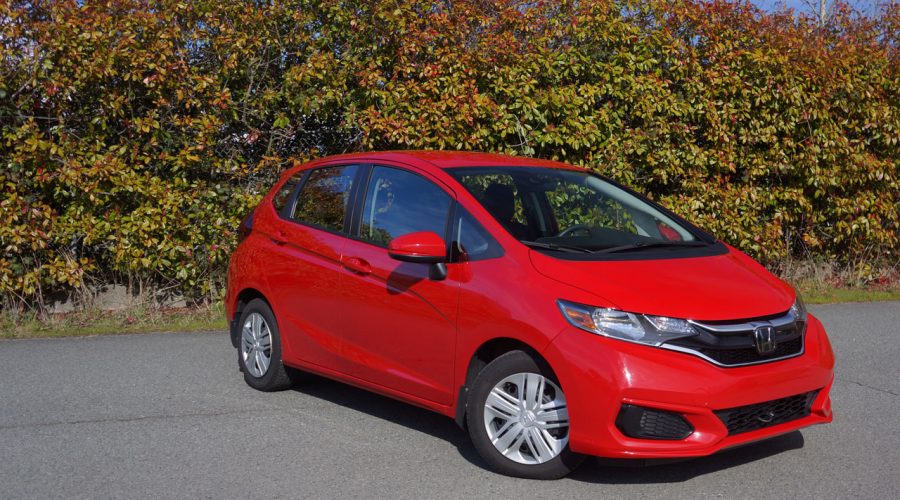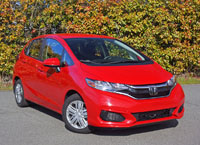
The Fit is the least expensive way to put a Honda car in your garage, but it just might be the smartest choice no matter how much you’d be willing to spend.
Ok, the same Japanese brand’s HR-V subcompact crossover SUV incorporates the same ultimately innovative rear seating system, illusively dubbed Magic Seat, with even more cargo room, so either model might do the trick, but being that this Fit starts at just $15,590 compared to the HR-V’s $23,300 price tag, it’s the perfect choice for active lifestyle folks on more of a budget.
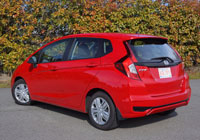
To be clear, my 2019 Fit tester was in second-rung LX trim, upgraded yet further with its optional continuously variable transmission (CVT), to its asking price moved up from $18,990 for the six-speed manual to $20,290, but the LX CVT with Honda Sensing not only provides the LX trim’s body-colour rear roofline spoiler, an auto-up/down driver’s window, illuminated steering wheel-mounted audio and cruise controls, larger infotainment touchscreen incorporating Apple CarPlay and Android Auto smartphone integration, multi-angle rearview camera with dynamic guidelines, Siri Eyes Free compatibility, text message function, Wi-Fi tethering, extra USB device connector (for a total of two), filtered air conditioning, heatable front seats, centre console with armrest and storage bin, HondaLink Assist automatic emergency response system, cargo cover and more, but also includes forward collision warning with automatic emergency braking, lane departure warning, lane keeping assist, road departure mitigation, an ECON mode button, and the list goes on.
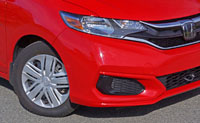
The LX gets everything from the base model too, a shortlist including auto-off multi-reflector halogen headlamps, LED brake lights, heated power-adjustable side mirrors in body-coloured housings, body-colour door handles, remote entry, powered locks and windows, intermittent front and rear wipers, a tilt and telescopic steering column, 160-watt four-speaker AM/FM/MP3/WMA audio, Bluetooth phone connectivity with streaming audio, etcetera.
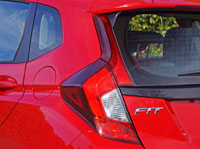
The Fit has always been a bit polarizing visually, but what subcompact hatchback is a style leader? Maybe Kia’s Rio could be called good looking, but most entry-level buyers likely agree this third generation Fit is a lot more eye-catching than the bland original and slightly less bland second generation, or at least it was for me, while the most recent 2018 refresh that adds yet more of Honda’s edgy new design language makes it look even better.
This upgrade came with an even edgier new Sport trim that I covered last year, this model’s $19,990 price placed right in the middle of four additional trims including base DX, my tester’s LX designation, $22,290 EX, and the $24,390 top-line EX-L NAVI. If you ask me, as much as I like the glossy black alloys and additional black and red exterior trim of the Sport, plus the performance-oriented black and red interior upgrades, the LX is probably the smartest option from a purely pragmatic point of view.
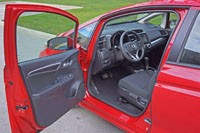
It’s an “everything you need, nothing you don’t” argument as verified by the features list above, the only upgrade I’d like being proximity-sensing access and pushbutton ignition, while once inside any Fit, old or new, or better yet having lived with one for enough time to experience how brilliantly practical it is, you’ll appreciate that styling matters a lot less than choosing the right car to accomplish the things you want to do. It’s the pragmatic minivan argument shrunken down to genuinely small proportions, yet play around awhile with its Magic Seat configurations and you’ll quickly understand that size really doesn’t matter when innovative engineering is factored in.
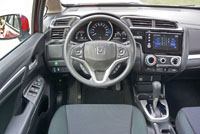
It’s long been one of the roomiest cars in its class, and the most versatile by far. People thinking they need to go full-size for more headroom had best expand their vision, as most will be cranking the Fit’s height-adjustable driver’s seat upward in order to take advantage of all the space overhead, thus providing a near SUV-like downward view at adjacent traffic below. The same can be said for legroom, which is more plentiful than most four-door sedans, while the Fit’s cargo space superiority certainly lives up to its name.
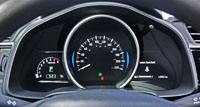
For those not familiar with the Fit’s rear Magic Seats, at first glance they seem to provide the same 60/40 split-folding second row as every competitor, not even including a centre pass-through, or my favourite 40/20/40 rear seat divide, but upon closer inspection it’s easy to see those rear seats sitting upon folding metal legs that allow the lower cushions to be lifted up against the seatbacks like those in the rear compartments of some pickup trucks. This provides a large 139-litre (4.9 cubic-foot) area for loading in tall cargo, like potted plants or bicycles (with front wheels removed), while still leaving all 470 litres (16.6 cubic feet) of available cargo space behind the second row. Drop those cushions back in place before pushing the rear seats into the floor exposes 1,492 litres (52.7 cubic feet) of maximum gear-toting capacity. That’s a lot for this class, and even the larger compact class. Yes, even Honda’s own Civic Hatchback is short some 184 litres (6.5 cubic feet) of maximum cargo volume when compared to the Fit.
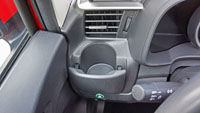
It’s good for people too, the Fit’s front seats providing wonderful comfort with excellent support, firm but not overly so. The steering column’s reach is ample for the majority of body types, making for an ideal driving position. Likewise, the rear outboard positions offer good comfort, having left my five-foot-eight long-legged, short-torso frame about five inches ahead of my knees and more than enough room to stretch out my legs when the driver’s seat was positioned for my height, plus about three and a half inches above my head and four or so next to my shoulders and hips.
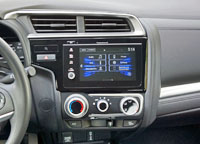
Parked in that driver’s seat, a mostly digital gauge cluster gets a large three-dimensional speedometer at centre, this being the only analogue component, that’s surrounded by brilliant blues, greens and reds on a deeply contrasted black background, these highlighting various functions of the multi-information display mounted within the just-noted speedometer. The steering wheel switchgear that controls it, and other features, are excellent, and there are plenty of them.
Move over to the centre stack you’ll find one of the best infotainment displays in the segment, filled with smartly organized digital buttons leading to simply laid out function interfaces, with the audio panel augmented by a throwback analogue power/volume knob that I appreciated for its easy adjustment while driving. Just below is a compact manual HVAC panel nicely detailed with large dials featuring knurled metal-like grips.
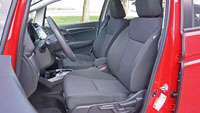
As you might expect in this needs-driven class, the upper dash top is made from harder plastic, but Honda goes a step further than most subcompact rivals by finishing off the instrument panel ahead of the front passenger in a nicely sculpted soft-touch synthetic, while over on the other side is a handy feature not offered by any challenger, a pop-out cupholder just to the left of the steering wheel, where it’s easier to reach. It’s positioned directly in front of the corner vent, so will either heat up or cool down your drink depending whether you have the heat or air conditioning on. This can be a pleasant bonus, but take note it can also warm up a bottle of water.
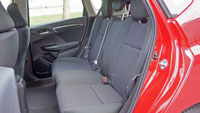
Believe it or not, the aforementioned Sport model and two trims above actually get a set of paddle shifters attached to the steering wheel next to that cupholder, which says a lot about this car’s drivability. Ahead of the firewall is a 1.5-litre four-cylinder engine that puts out a surprisingly strong 130 horsepower and 114 lb-ft of torque, or 128 and 113 respectively when hooked up to its optional CVT. Those numbers lift it into rare territory for this class, with only one base competitor making more. This provides a bit of fun off the line, more so for the manual, yet still plenty of straight-line speed for the CVT as well, plus decent highway passing performance and enough on tap to power out of corners when tackling the twisties.
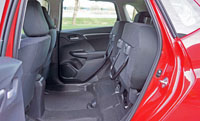
And yes, despite its front strut and rear torsion beam suspension, the latter allowing for all that cargo space mentioned before, it carves a fairly quick corner, only becoming unsettled when pushed too hard through winding, bumpy pavement. This said the Fit was really designed more for urban commuting than blasts down rural mountainside two-laners, its ride set up for comfort first and foremost, and therefore providing good compliance over rough patches of inner-city tarmac.
Commuting in mind, the Fit’s claimed 8.1 L/100km city, 6.6 highway and 7.4 combined rating for the manual is very good, although the CVT is even easier on the wallet at only 7.0 city, 5.9 highway and 6.5 combined. Some rivals offer slightly better efficiency, but not together with the Fit’s performance, especially when comparing automatic transmissions.
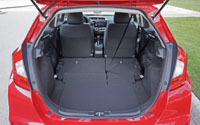
Summing up, the Fit is one of the better subcompacts to drive while providing superb fuel economy and unparalleled practicality, all together with good comfort, plenty of leading convenience features and safety technologies, plus Honda’s good name to keep it reliable and prop up its resale value. The Fit gets a pretty dramatic facelift for 2020, so make sure to visit CarCostCanada for all the latest rebate info on 2019s, as Honda retailers will be motivated to discount them. Also, before you try to negotiate, find out about the dealer invoice price so you know exactly what the retailer is paying in order to get the best deal possible. CarCostCanada is currently showing up to $1,000 off in additional incentives, so make sure you check out all the details before visiting your local retailer, and also learn about the 2019 Fit’s additional trims, packages and individual options.

